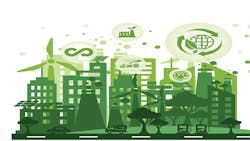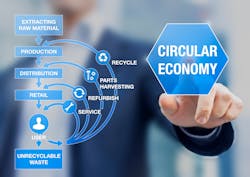STANDARDS & PROGRAMS | TM66 delivers a metric for evaluating lighting circularity claims
Circular economy principles have been widely discussed in the building and construction industry, but the model is in its early adoption phase. Perhaps we should call it a “re-adoption,” since before the transition to LED, part of regular maintenance was changing lamps and cleaning fittings — which could subsequently achieve long lives.
LEDs afforded building managers and owners the opportunity to extend maintenance schedules, but a simultaneous rush to reduce capital cost meant that some compromised fittings were placed on the market. As they failed without a means of repair, these fittings and all materials embedded in them went into the trash.
What had gone wrong? A laser focus on return on investment (ROI), enabled by LEDs' improved efficacy over traditional light sources to deliver low operating expenses then became the driver of ever lower capital expense to give quicker ROIs. The sales pitch was simple. Proponents and stakeholders looked at the use phase: We saved energy, and we didn’t evaluate the impacts of manufacturing or disposal on the planet because we thought we didn’t have to.
Today, sustainability sells, but beware of greenwashing. Manufacturers must ensure claims are backed up with hard facts, deep research, and credible metrics. To an extent, sustainability regulation is already under way in the European Union, with more directives to come. In a truly “green” organization, sustainability is embodied into its DNA and is coded into its thinking, processes, and KPIs.
Linear economy vs. life cycle thinking
The long-established model of the linear economy is Take, Make, Waste (see the left side of Fig. 1). We take resources from the earth, make and use products, and when we’ve used them, we throw them and their embodied energy and resources away. This is what global society has done for the last 200 years because resources seemed infinite. Without accounting for any environmental damage or cost, it is the cheapest way to manufacture and get things.
When we speak about moving toward a circular economy, we are instead considering the entire life cycle of a product, its materials and components, and how we can reuse, repair, or recycle the product in order to maximize its usefulness (as the right-side circles demonstrate in Fig. 1).
To implement a circular economy model, we need a method by which to assess the life cycle of products and their component materials. Currently, lighting specification decisions are based on design and engineering metrics such as illuminance, glare, color temperature, capex, and opex. What is missing is a method that measures the degree of circularity.
As previously stated, up until very recently we concentrated on the in-use phase of products. For a light fitting, cradle to gate is the environmental impact from resource extraction to fitting delivery on site. Cradle to grave takes us to end-of-life disposal. Circular economy is cradle to cradle, a model in which the fitting or its parts are reengineered or remanufactured to become the next one (see Fig. 2).
Where does TM66 fit into the model?
Developed by industry volunteers from the Chartered Institution of Building Services Engineers (CIBSE), its Society of Light and Lighting (SLL), and the Lighting Industry Association (LIA), TM66 provides a simple metric for improved cradle-to-cradle performance of material in a light fitting. It does not consider soil, air, or water pollution in detail, but it does look at circular economy in depth.
TM66 acts as a transition tool to help the lighting industry plan and report on improving circularity performance. In fact, it can go beyond that because TM66, associated educational webinars, and this article actively promote and enable a circular economy process.
In focusing on the circular economy, TM66 is intended to keep embodied resources productive (and thus valuable) for as long as possible — by a mix of product life (quality and durability) and product life extension by repairability and/or the ability to remanufacture.
Durability, repairability, and distance
There are two schools of thought regarding how to deliver a long service life. We can build a product to be durable or build it to be re-engineerable. In fact, both could be valid; they are not necessarily mutually exclusive, and the right solution for any particular fitting lies somewhere on a scale between them.
“Built to last,” “sealed for life,” “fit and forget,” and “high quality” are all phrases that imply the product should reliably deliver its required performance over a long service life. A product design with minimal connections and sealed construction may not facilitate remanufacturing or even repair. The argument is that too few products fail to warrant the extra complexity of accessible, replaceable components.
The counter-argument is that the rate of change in modern buildings has now outpaced the service life of a well-made product. And still some components — for example, LED drivers — can fail, which can either result in driver or entire fixture replacement. A fitting expected to last from 10 to 20 years that does not allow repair and remanufacture is compromised. Components also improve, new technologies arise, and the buildings where they are installed change in use. For example, post-COVID, many office spaces are being used differently than they were previously designed and equipped.
Another factor to consider in developing more circular products is the distance involved in their manufacture and distribution. While the distance between factory and market of course affects transport CO2, it also affects communication between market and factory. Without local technical support trained on how to repair a product in the local market and readily available spare parts, the circular economy will be more difficult to establish.
Refer back to Fig. 1 and the linear model on the left. With a circular economy model in place, when a fitting has failed or the space has been changed, the existing product can be altered to maintain its highest level of economic and functional value for as long as possible.
So don’t shred a failed fitting — fix it. If it no longer meets the needs of the installation space, return it for remanufacture, upgrade, or modification. The fitting becomes a new product but retains as much value from the prior version as possible. After these considerations, if the fitting has little life left in its present form, then harvest useable parts. Only after this process has been exhausted would we recycle the remaining materials.
The creation of TM66 and CEAM
In developing TM66, collaborators soon saw the need for a checklist to deliver detailed advice on how to implement circular economy principles in the lighting product design process, but team member and lighting designer Mark Ridler suggested a key innovation:
“As a specifier we need a checklist that you can tick or mark a number in so that minimum standards can be negotiated with a client and then defended in ‘equal and approved’ scenarios… It will be excellent if this paper could agree this for general adoption by consultants. Also, it should be revised as the industry improves.”
With this feedback in mind, the TM66 team moved from a simple checklist to the more complex but more useful TM66 Circular Economy Assessment Method (CEAM). Note that the volunteers included both specifiers and manufacturers, and the team deliberately thought in terms of market economics, to stimulate both demand pull and supply push of circular economy–enabled products.
The four tabs of TM66’s Circular Economy Assessment Method
Product Design tab. It is easier to design a track spotlight to be circular than an ingress-protected floodlight, thus weighting ensures comparable results. The Product Design tab contains 33 separate, weighted criteria for assessment across 12 areas including reusability, upgradeability, burning hours monitoring, repairability, durability, material usage and sourcing, harmonization of component usage, fixings (or fastenings — screws versus glues), design for remanufacture, resilience to digital control obsolescence competence, and buy-in.
Manufacturing tab. One challenge is that some parts of the circular economy have not been designed yet, principally the ecosystems of services that will support it. The lighting industry understands logistics — for example, getting an LED panel from Guangzhou to Greensboro via ship, truck, and installer. But how do we create reverse logistics, where someone picks the product up again for repair, reuse, upgrade, or component recovery? Thus, under the Manufacturing tab, we look at localism, supply chains, and closed-loop manufacturing.
Materials tab. The Materials tab reviews the reusability and recyclability of materials in general, including natural, innovative ones as well as packaging. It also looks at how to ensure these materials are separable in the waste stream.
CEAM – Make, Ecosystem tab. The Ecosystem tab evaluates how to support a luminaire in its second life, covering burning hours monitoring, access to photometry, and supplier commitment to support.
Scoring — From zero to hero. All the complexity and thought combines to produce a simple, easily comparable rating out of 4. Therefore, in the fifth tab all the results are brought together in a summary and simply explain what the end number means. This system shows the user tab-by-tab results, then an overall score accompanied by a red to green explanation of whether that score is adequate. Currently a good score is between 2.7 and 2.9.
Success and next steps
In 2021, TM66 and CEAM won both the Green and Platinum Build Back Better Awards for sustainability and an initiative likely to drive change, respectively. In Mondo Arc, Ridler stated of the TM66 initiative and its reception:
“TM66 is I think a massive achievement. The rigour, intellectual background, ethical motivation, detail and structure are excellent and hugely commendable. CEAM checklists are exactly what has been called for from the lighting community in order to evaluate product CE performance, communicate this to clients and defend from product substitution.”
The team behind TM66 and CEAM continues to learn from the CEAM Beta version and are gathering feedback to be incorporated into the full Release 1. Sub-teams are working on additional modules covering lighting controls, emergency lighting, and facilities management.
To ensure successful implementation across the industry, the TM66 Circular Economy Assured program combines the ongoing work and expertise from CIBSE members in developing CEAM along with the LIA’s Quality Assurance systems and independent UKAS accredited laboratory. The scheme reviews manufacturer’s CEAM assessments to ensure that the questions have been interpreted clearly, and that all responses are accurate, reasonable, up-to-date, informed, grounded in reality, and backed by evidence.
Interested parties can download the latest TM66 Assured program documentation, find online training seminars, apply for certification, and search for TM66 certified products on the LIA website.
BOB BOHANNON is head of policy and sustainability at the U.K.-based Lighting Industry Association. He led the team responsible for developing the TM66 CEAM in partnership with CIBSE and its Society on Light and Lighting. During his time as an independent lighting design consultant, Bohannon worked on projects ranging from municipal transportation and mass transit centers to cultural venues and more.
Follow our LinkedIn page for our latest news updates, contributed articles, and commentary, and our Facebook page for events announcements and more. You can also find us on the X platform.
Bob Bohannon
BOB BOHANNON is head of policy and sustainability at the U.K.-based Lighting Industry Association. He led the team responsible for developing the TM66 CEAM in partnership with CIBSE and its Society on Light and Lighting. During his time as an independent lighting design consultant, Bohannon worked on projects ranging from municipal transportation and mass transit centers to cultural venues and more.







![The DesignLights Consortium continues to make progress in shifting outdoor lighting products and implementation practices toward a more restrained and thoughtful strategy. [Image does not represent a DLC qualified fixture.] The DesignLights Consortium continues to make progress in shifting outdoor lighting products and implementation practices toward a more restrained and thoughtful strategy. [Image does not represent a DLC qualified fixture.]](https://img.ledsmagazine.com/files/base/ebm/leds/image/2024/08/66be810888ae93f656446f61-dreamstime_m_265700653.png?auto=format,compress&fit=&q=45&h=139&height=139&w=250&width=250)